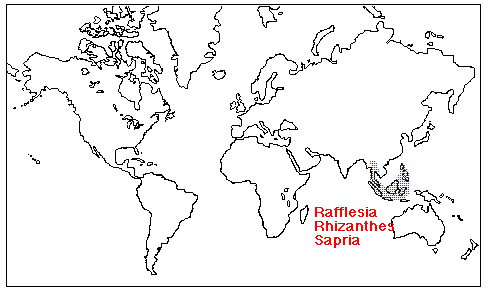 |
Rafflesiaceae Dumort.
|
Distribution Map

Photographs
Rafflesia
Rhizanthes
Rhizanthes deceptor. The name alludes to Rhizanthes's
notoriety in deceiving flies and scientists alike!
- Flower. Ulu Gadut (nr. Padang, Bt.
Gambir), Sumatra. Photograph by W. Meijer.
- Female flower, ca. 12 hours
after it started opening around midnight. Photo from Bänziger
and Hansen (2000, Nat. Hist. Bull. Siam Soc. 48: 117-143) used with
permission.
Rhizanthes infanticida. Photographs from
Bänziger (1995, Nat. Hist. Bull. Siam Soc. 43: 337-365) and Bänziger and
Hansen (2000, Nat. Hist. Bull. Siam Soc. 48: 117-143) used with
permission. The specific name, which means "to kill young children"
alludes to the flower's pollination syndrome which leads to the death of
the pollinators' brood.
Rhizanthes lowii.
Photograph from Bänziger and Hansen (2000,
Nat. Hist. Bull. Siam Soc. 48: 117-143) used with permission.
- Male flower
with very long ramenta pad. Photo by A. Kocyan.
Sapria
Sapria himalayana forma himalayana. Photographs from
Bänziger, Hansen and Kreetiyutanont (2000, Nat. Hist. Bull. Siam Soc. 48:
213-219) used with permission.
- Opening flower.
Thailand. Photo by Hans Bänziger.
- Comparison
of the typical form of S. himalayana (left) and forma albovinosa
(right); both male flowers. The warts on the flower on the left are
yellow and the ones on the right are white.
Sapria himalayana forma albovinosa. Photographs from
Bänziger, Hansen and Kreetiyutanont (2000, Nat. Hist. Bull. Siam Soc. 48:
213-219) used with permission.
Sapria poilanei. Photographs from Bänziger and Hansen (1997, Nat.
Hist. Bull. Siam Soc. 45: 149-170) used with permission.
Sapria ram. Photographs from Bänziger and Hansen (1997, Nat.
Hist. Bull. Siam Soc. 45: 149-170) used with permission.
Phylogeny
Certainly the most substantial rearrangement of parasitic plants since Kuijt
(1969) has involved plants classified in “Rafflesiales” (or
Rafflesiaceae s. lat.). It has long been recognized to contain four
different components:
• the “large-flowered clade” (including Rafflesia,
Rhizanthes, and Sapria).
Rafflesiaceae s. str.
• the “hypogynous” clade with only Mitrastema.
Mitrastemonaceae.
• the “inflorescence clade” (composed of Cytinus
and Bdallophyton). Cytinaceae.
• the “small-flowered clade” (composed of Apodanthes,
Berlinianche, and
Pilostyles). Apodanthaceae.
Although these four components were recognized, most treatments, including
Kuijt (1969) discussed them together. Indeed they do share several
morphological features. But if one were to split them, where among
photosynthetic angiosperms would the components be placed? This question
could only be solved using molecular methods.
Nickrent et al. (2004 BMC Evol. Biol. pdf HERE)
used both nuclear 18S rDNA and mitochondrial matR sequences to address the
relationships of above four clades. The gene trees showed the
polyphyletic nature of Rafflesiales. Rafflesiaceae s. str. came out in
Malpighiales, in agreement with Barkman (2004) and later Davis et al.
(2007). Cytinus and Bdallophyton
were strongly supported as members of Malvales. A later study (Nickrent 2007
HERE)
showed that within the order, Cytinaceae is most closely related to the New
World family Muntingiaceae. Mitrastemonaceae emerged as a member of
Ericales, also in agreement with the Barkman study. The nuclear and
mitochondrial sequence data were ambiguous with regard to the position of
Apodanthaceae, with nuclear rDNA data supporting a position with Malvales
(contamination) and mitochondrial matR data with Cucurbitales. Additional
sequencing and analyses indicated Apodanthaceae was part of Cucurbitales.
This result was confirmed by Filipowicz and Renner (2010).

Last updated:
Monday, November 16, 2020



